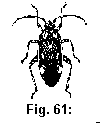 Zoom Fig.
61: full view, Tarnished plant bug A, Adult. B to E, Nymphs.
Zoom Fig.
61: full view, Tarnished plant bug A, Adult. B to E, Nymphs. Return to: MREC Home Page Return to: Key to Bugs
DESCRIPTION
Adult- The tarnished plant bug is oval and pale yellow with a few black markings or reddish brown to black with a few pale yellow markings. There is sometimes a characteristic white triangle between its shoulders. The antennae and legs are relatively long. Males are 5 to 6 mm long and females are up to 6.5 mm long.
Egg- The egg is small, truncate and slightly curved. It is about I mm long and 0.25 mm wide.
Nymph- Newly hatched nymphs are yellowish green and about I mm long. Older nymphs are yellow green to green and wingless. As they mature the nymphs develop yellow, green or black spots. Older nymphs have four black spots on the thorax and one on the abdomen. The head is light green. There are five nymphal instars. The full-grown nymph has wingpads and is about 4 to 4.5 mm long.
Fig. 61. Tarnished plant bug, Lygus lineolaris (Palisot
de Beauvois), Miridae, HEMIPTERA
 Zoom Fig.
61: full view, Tarnished plant bug A, Adult. B to E, Nymphs.
Zoom Fig.
61: full view, Tarnished plant bug A, Adult. B to E, Nymphs.
BIOLOGY
Distribution- This plant bug is found throughout the United States. It prefers warm, humid to dry climates in the South, Southeast, and Southwest.
Host Plants- The host range of this pest seems endless. It attacks some 50 species of economic plants, including fruits, vegetables, ornamentals, field, and forage crops. Greenhouse hosts include asters, chrysanthemums, dahlias, impatiens, and marigolds. Weed hosts include butterweed, fleabane, goldenrod, vetch, dock, and dog fennel.
Damage- The tarnished plant bug is among the most damaging of the true bugs. The bugs use their needlelike mouthparts to extract plant juices. These bugs are known to transmit plant diseases. Their feeding causes terminal growth to be yellowed or distorted thereby reducing plant growth and causing them to appear unthrifty. Leaves from damaged buds are sometimes ragged and discolored. Flowers from damaged buds sometimes fail to develop on one side or the whole bud aborts.
Life History- In the South (warmer states) all stages of the tarnished plant bug may be found year round. In cooler climates the adults overwinter in litter or other trash in protected areas, such as woods or ditch banks along fields. Once established in greenhouses, a population may breed continuously unless the cycle is broken by good sanitation or chemical controls. Reinfestation usually occurs through unscreened vents or doors during ventilation. The adults and young feed on the young tender growth of plants but usually prefer the foliage.
Oviposition is in the young tender stem, leaves or flowers of plants in the composite family. Egg hatch occurs in about I to 3 weeks. Eggs deposited in the veins or the leaves cause tiny swellings. The nymphs pass through five instars over a 2- to 3-week period and the whole life cycle takes 3 to 4 weeks. The nymphs usually remain in the area of hatching, 27 but as adults the bugs are very active and fly freely. The tarnished plant bug is prolific and produces several generations a year. Peaks of abundance for adult tarnished plant bugs are usually in early July, early August, and early September.
CONTROL
Removal of preferred host plants from around greenhouses and cleaning up favorable overwintering sites should help reduce numbers of tarnished plant bugs for the following year. For specific chemical controls, see the current Cooperative Extension publications on ornamental plant pests or contact your local county Extension agent.
University of Florida/IFAS Reference to Pest Control Guides